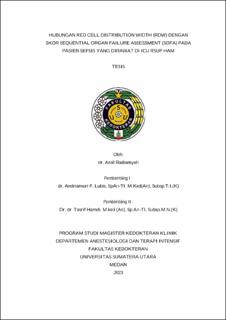Hubungan Red Cell Distribution Width (RDW) dengan Skor Sequential Organ Failure Assessment (SOFA) pada Pasien Sepsis yang Dirawat di ICU RSUP Ham

Date
2023Author
Radiansyah, Arsil
Advisor(s)
Lubis, Andriamuri Primaputra
Hamdi, Tasrif
Metadata
Show full item recordAbstract
Introduction: Globally there are an estimated 31.5 million cases of sepsis per year
and approximately 61% end up in sepsis shock with a potential mortality of 5.3
million per year. In addition to using the Sequential Organ Failure Assessment
(SOFA) scoring system, several biomarkers have been used to assess severity and
predict mortality including Red Cell Distribution Width (RDW). RDW can increase
in conditions of ineffective red blood cell production or increased blood cell
destruction that occurs in inflammatory or infectious conditions. RDW above
15.5% is significantly associated with rigid and difficult to disintegrate red blood
cells, which can impede blood flow in the microcirculation and contribute to
multiple organ dysfunction in sepsis, which is a reflection of the SOFA score.
Objective: The aim of this study was to determine the correlation between RDW
and SOFA score in sepsis patients admitted to the ICU of Haji Adam Malik General
Hospital Medan.
Methods: This study uses a cohort- prospective design. The data obtained will be
analyzed with pearson or spearman analysis test.
Results: There is a significant correlation between RDW and SOFA score (r=0,471;
p<0.05) in ICU sepsis patients. There was a significant correlation (p = 0.003)
between RDW values and SOFA scores on the third day (T3) where there was a
moderate degree of correlation (r = 0,471), but there was no significant correlation
(p = 0.103) between RDW values and SOFA scores on the first day (T0). The
sensitivity, specificity, and cut-off values of RDW were found to be 76.5%, 75%,
and 14.75% which compared to SOFA were 76.5%, 75%, and 10.5.
Conclusion: There is a statistically significant correlation between RDW and
SOFA with a moderate degree of correlation.
